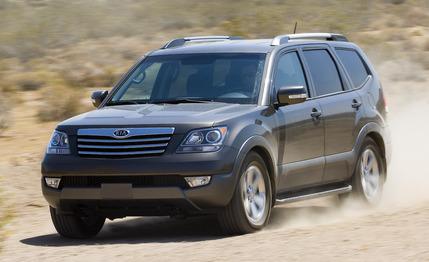
 First Drive Review
First Drive Review
We don’t have to tell you that we’re total power hogs here at Car and Driver . But alas, even the most gluttonous among us also recognizes that now is the time to promote prudence in our lives; and as long as a given automobile’s base powertrain is sufficient, we won’t make the hard sell for the steroid-enhanced version.
The 2009 Kia Borrego is one such case where the base engine—a 276-hp, 3.8-liter V-6—is good enough to render the larger 337-hp, 4.6-liter V-8 somewhat moot, unless one needs to tow 2500 more pounds than the 5000 the V-6 model is rated to tug. On a recent test of a four-wheel-drive Borrego V-6 in Southern California, not only was its 267 lb-ft of torque plenty to pull the three-row body-on-frame SUV without complaint, but the six’s smooth, refined character recalls the Hyundai Genesis’s 290-hp V-6 with which it shares much of its design and components. With lots of people and cargo aboard, we can see the V-6 getting a little slow, but with just a driver—which, let’s face it, is the way these things are driven most of the time—the base engine is quite sufficient. The only other Borrego we’ve tested was a 4870-pound, four-wheel-drive V-8 model, which delivered a none-too-impressive 16 mpg (we averaged a similarly unimpressive 18 during our stint with the V-6).
Hard Ride
Happily, all Borregos feature unequal-length front and independent multilink rear suspensions that, based on our previous test as well as this one, offer respectable handling. However, skateboard-stiff spring and shock settings make for jumpy ride quality and allow road impacts to rumble about the underpinnings almost as if a solid rear axle were fitted underneath. During our time with the V-6 model, we drove from Los Angeles to San Diego and back—right past Kia’s slick new U.S. headquarters, in fact—on the wretched, chewed-up patchwork of asphalt known to Southern California commuters as I-5. We found ourselves praising the engine but cursing the suspension at the termination of each two-hour journey, even stopping to get out in Irvine to get a break from the jostling.
Spacious, but Not Special
The interior of this particular $36,295-as-tested model presented us with a full boat of high-line features—including a $1500 navigation system (with a delightfully straightforward interface), a $1500 leather package, and an $1800 premium package that added a sunroof, a 10-speaker Infinity sound system, rear A/C, and gleaming 18-inch chrome wheels. In spite of its flush surfaces and tight assembly tolerances, though, the interior materials and the bland gauge cluster don’t seem any more upscale or modern than those in the outgoing Kia Spectra compact car. There aren’t too many hard plastic surfaces to offend, but there also aren’t too many chrome cuffs or high-line finishes to delight.
A Vehicle Whose Time Has Come—and Gone?
With its jarring ride quality, so-so interior, and (admittedly handsome) 1990s-styling, the body-on-frame Borrego is a capable—if not terribly special—truck whose day may indeed have come before it was even conceived. On one hand, the V-6 model is sufficiently powerful and accommodating, but so are most three-row crossovers these days, almost all of which offer better ride quality and fuel economy. The V-8 model’s towing capacity is better, but no more so than that of other full-size utes one can buy for about the same price these days.
Ten years ago, people actually valued off-road abilities and endured mediocre interiors. These days, fuel economy greater than a combined 18 mpg seems more front and center on people’s minds, and interior quality is an expectation, not an aspiration. Also, these days customers have many choices in the segment—the Honda Pilot, the Chevrolet Traverse, and the Mazda CX-9, for example—one or more of which are bound to be better matches than the Borrego.